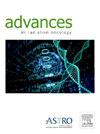利用虚拟 CT 和治疗时核磁共振成像减少采用强度调节质子疗法的儿科患者在自适应工作流程中的辐射剂量和麻醉暴露量
IF 2.2
Q3 ONCOLOGY
引用次数: 0
摘要
本研究的目的是确定在我们的临床工作流程中,由日常锥形束计算机断层扫描(CBCT)或治疗中磁共振成像(MRItx)衍生的虚拟计算机断层扫描(vCT)是否可以取代质量保证计算机断层扫描(qCT),从而最大限度地减少成像剂量,并降低需要调整计划的患者的潜在麻醉暴露。对于需要进行计划调整的病例,在 vCT 上重新计算剂量,并与当天的 qCT 和原始计划计算机断层扫描 (pCT) 进行比较。引发计划调整的解剖变化被分为不同类别。两位儿科放射肿瘤专家验证了这些变化是否能通过 CBCT、qCT 和/或 MRItx 检测出来。结果 从 2020 年到 2023 年,共有 168 名儿科患者接受了治疗。所有患者共进行了 517 次 qCT 扫描和 61 次 MRItx。每位患者的qCT扫描次数中位数为3次(1-5次不等)。20 名患者(12%)的治疗计划进行了调整。在所有需要调整计划的患者中,当比较 vCT 与 pCT 和 qCT 与 pCT 时,目标覆盖的剂量差异和最大身体剂量之间存在相关性(分别为 n = 20、r2 = 0.79、P < .01 和 r2 = 0.32 P = .01)。最常见的适应原因是射束路径中的组织变化(如炎症、腹腔气体变化或横膈膜变异)(10/20)和肿瘤体积变化(6/20)。所有体重变化、射束路径中的组织变化和不可再现的设置均可在 CBCT 上检测到。所有脑内肿瘤体积的变化都能在核磁共振成像上检测到。在我们的临床工作流程中,用 vCT 替代 qCT 可使成像剂量中位数减少 50%,麻醉暴露时间减少 1.5 小时。这种改变有可能减少成像剂量和麻醉暴露。本文章由计算机程序翻译,如有差异,请以英文原文为准。
Use of Virtual CT and On-Treatment MRI to Reduce Radiation Dose and Anesthesia Exposure Associated With the Adaptive Workflow in Pediatric Patients Treated With Intensity Modulated Proton Therapy
Purpose
The purpose of this study was to determine whether virtual computed tomography (vCT) derived from daily cone beam computed tomography (CBCT), or on-treatment magnetic resonance imaging (MRItx) can replace quality assurance computed tomography (qCT) in our clinical workflow to minimize imaging dose and potentially anesthesia exposure in patients requiring plan adaptation.
Methods and Materials
Pediatric patients (age <24 years) treated from 2020 to 2023 with intensity modulated proton therapy with at least 1 qCT during proton therapy were eligible. For cases that required plan adaptation, the dose was recalculated on vCT and compared with same-day qCT as well as the original planning computed tomography (pCT). Anatomic changes triggering plan adaptation were grouped into categories. Two pediatric radiation oncologists verified whether these changes could be detected using CBCT, qCT, and/or MRItx. A new adaptive imaging workflow was proposed to limit imaging dose and anesthesia exposure.
Results
One hundred sixty-eight pediatric patients were treated from 2020 to 2023. Across all patients, there were 517 qCT scans and 61 MRItx acquired. The median number of qCT scans per patient was 3 (range, 1-5). The treatment plans for 20 patients (12%) were adapted. In all patients requiring plan adaptation, there was a correlation between dose differences in target coverage and maximum body dose when comparing vCT with pCT and qCT with pCT (n = 20, r2 = 0.79, P < .01, and r2 = 0.32 P = .01, respectively). The most common reason for adaptation was tissue change (eg, inflammation, changes in abdominal gas, or diaphragmatic variability) in the beam path (10/20) and changes in tumor volume (6/20). All cases of weight change, tissue change in beam path, and unreproducible setup could be detected on CBCT. All cases of change in tumor volume within the brain were detected on MRItx. Replacing the qCT with the vCT was associated with an estimated median reduction of imaging dose by 50% and anesthesia exposure by 1.5 hours.
Conclusions
vCT derived from daily CBCT only or MRItx can safely replace qCT for monitoring dosimetric changes to trigger a new pCT in our clinical workflow. This change would potentially reduce imaging dose and anesthesia exposure.
求助全文
通过发布文献求助,成功后即可免费获取论文全文。
去求助
来源期刊

Advances in Radiation Oncology
Medicine-Radiology, Nuclear Medicine and Imaging
CiteScore
4.60
自引率
4.30%
发文量
208
审稿时长
98 days
期刊介绍:
The purpose of Advances is to provide information for clinicians who use radiation therapy by publishing: Clinical trial reports and reanalyses. Basic science original reports. Manuscripts examining health services research, comparative and cost effectiveness research, and systematic reviews. Case reports documenting unusual problems and solutions. High quality multi and single institutional series, as well as other novel retrospective hypothesis generating series. Timely critical reviews on important topics in radiation oncology, such as side effects. Articles reporting the natural history of disease and patterns of failure, particularly as they relate to treatment volume delineation. Articles on safety and quality in radiation therapy. Essays on clinical experience. Articles on practice transformation in radiation oncology, in particular: Aspects of health policy that may impact the future practice of radiation oncology. How information technology, such as data analytics and systems innovations, will change radiation oncology practice. Articles on imaging as they relate to radiation therapy treatment.
 求助内容:
求助内容: 应助结果提醒方式:
应助结果提醒方式:


